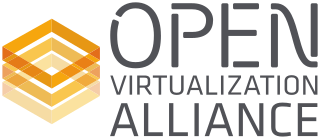Related Research Articles
A hypervisor is a type of computer software, firmware or hardware that creates and runs virtual machines. A computer on which a hypervisor runs one or more virtual machines is called a host machine, and each virtual machine is called a guest machine. The hypervisor presents the guest operating systems with a virtual operating platform and manages the execution of the guest operating systems. Unlike an emulator, the guest executes most instructions on the native hardware. Multiple instances of a variety of operating systems may share the virtualized hardware resources: for example, Linux, Windows, and macOS instances can all run on a single physical x86 machine. This contrasts with operating-system–level virtualization, where all instances must share a single kernel, though the guest operating systems can differ in user space, such as different Linux distributions with the same kernel.
In computing, paravirtualization or para-virtualization is a virtualization technique that presents a software interface to the virtual machines which is similar, yet not identical, to the underlying hardware–software interface.

virt-manager is a desktop virtual machine monitor primarily developed by Red Hat.

Raritan is a multinational technology company that manufactures hardware for data center power distribution, remote server management, and audio visual solutions. The company is headquartered in Somerset, New Jersey, and has a commercial presence in over 76 countries. Raritan was acquired by Legrand in September 2015.

Kernel-based Virtual Machine (KVM) is a free and open-source virtualization module in the Linux kernel that allows the kernel to function as a hypervisor. It was merged into the mainline Linux kernel in version 2.6.20, which was released on February 5, 2007. KVM requires a processor with hardware virtualization extensions, such as Intel VT or AMD-V. KVM has also been ported to other operating systems such as FreeBSD and illumos in the form of loadable kernel modules.

oVirt is a free, open-source virtualization management platform. It was founded by Red Hat as a community project on which Red Hat Virtualization is based. It allows centralized management of virtual machines, compute, storage and networking resources, from an easy-to-use web-based front-end with platform independent access. KVM on x86-64, PowerPC64 and s390x architecture are the only hypervisors supported, but there is an ongoing effort to support ARM architecture in a future releases.
Kimchi is a Korean side dish made from pickled vegetables.

libvirt is an open-source API, daemon and management tool for managing platform virtualization. It can be used to manage KVM, Xen, VMware ESXi, QEMU and other virtualization technologies. These APIs are widely used in the orchestration layer of hypervisors in the development of a cloud-based solution.
libguestfs is a C library and a set of tools for accessing and modifying virtual disk images used in platform virtualization. The tools can be used for viewing and editing virtual machines (VMs) managed by libvirt and files inside VMs, scripting changes to VMs, creating VMs, and much else besides. It was created because of security issues, when virtual disk images are mounted directly on the host system.
In computing, SPICE is a remote-display system built for virtual environments which allows users to view a computing "desktop" environment – not only on its computer-server machine, but also from anywhere on the Internet – using a wide variety of machine architectures.

OpenNebula is an open source cloud computing platform for managing heterogeneous data center, public cloud and edge computing infrastructure resources. OpenNebula manages on-premise and remote virtual infrastructure to build private, public, or hybrid implementations of Infrastructure as a Service and multi-tenant Kubernetes deployments. The two primary uses of the OpenNebula platform are data center virtualization and cloud deployments based on the KVM hypervisor, LXD/LXC system containers, and AWS Firecracker microVMs. The platform is also capable of offering the cloud infrastructure necessary to operate a cloud on top of existing VMware infrastructure. In early June 2020, OpenNebula announced the release of a new Enterprise Edition for corporate users, along with a Community Edition. OpenNebula CE is free and open-source software, released under the Apache License version 2. OpenNebula CE comes with free access to patch releases containing critical bug fixes but with no access to the regular EE maintenance releases. Upgrades to the latest minor/major version is only available for CE users with non-commercial deployments or with significant open source contributions to the OpenNebula Community. OpenNebula EE is distributed under a closed-source license and requires a commercial Subscription.

The Open Virtualization Alliance (OVA) was a Linux Foundation Collaborative Project committed to foster the adoption of free and open-source software virtualization solutions including KVM, but also software to manage such, e.g. oVirt. The consortium promoted examples of customer successes, encouraged interoperability and accelerated the expansion of the ecosystem of third party solutions around KVM.

Ganeti is a virtual machine cluster management tool originally developed by Google. The solution stack uses either Xen, KVM, or LXC as the virtualization platform, LVM for disk management, and optionally DRBD for disk replication across physical hosts or shared storage for external replication. Since 2007 Ganeti is developed and released as free and open-source software. Originally subject to the requirements of the GNU General Public License (GPL) version 2, the license was changed to the 2-clause BSD license in version 2.11.6, released September 2014.

GNOME Boxes is an application of the GNOME Desktop Environment, used to access virtual systems. Boxes uses the QEMU, KVM, and libvirt virtualization technologies.
CloudStack is open-source Infrastructure-as-a-Service cloud computing software for creating, managing, and deploying infrastructure cloud services. It uses existing hypervisor platforms for virtualization, such as KVM, VMware vSphere, including ESXi and vCenter, XenServer/XCP and XCP-ng. In addition to its own API, CloudStack also supports the Amazon Web Services (AWS) API and the Open Cloud Computing Interface from the Open Grid Forum.
openQRM is a free and open-source cloud-computing management platform for managing heterogeneous data centre infrastructures.

SmartOS is a free and open-source SVR4 hypervisor based on the UNIX operating system that combines OpenSolaris technology with bhyve and KVM virtualization. Its core kernel contributes to the illumos project. It features several technologies: Crossbow, DTrace, bhyve, KVM, ZFS, and Zones. Unlike other illumos distributions, SmartOS employs NetBSD pkgsrc package management. SmartOS is designed to be particularly suitable for building clouds and generating appliances. It was originally developed for and by Joyent, who announced in April 2022 that they had sold their business supporting and developing of Triton Datacenter and SmartOS to MNX Solutions. It is open-source and free for anyone to use.

Apache Stanbol is an open source modular software stack and reusable set of components for semantic content management. Apache Stanbol components are meant to be accessed over RESTful interfaces to provide semantic services for content management. Thus, one application is to extend traditional content management systems with semantic services.
bhyve is a type-2 hypervisor initially written for FreeBSD. It can also be used on a number of illumos based distributions including SmartOS, OpenIndiana, and OmniOS. A port of bhyve to macOS called xhyve is also available.

Proxmox Virtual Environment is a hyper-converged infrastructure open-source software. It is a hosted hypervisor that can run operating systems including Linux and Windows on x64 hardware. It is a Debian-based Linux distribution with a modified Ubuntu LTS kernel and allows deployment and management of virtual machines and containers. Two types of virtualization are supported: container-based with LXC, and full virtualization with KVM. It includes a web-based management interface. There is also a mobile application available for controlling PVE environments.